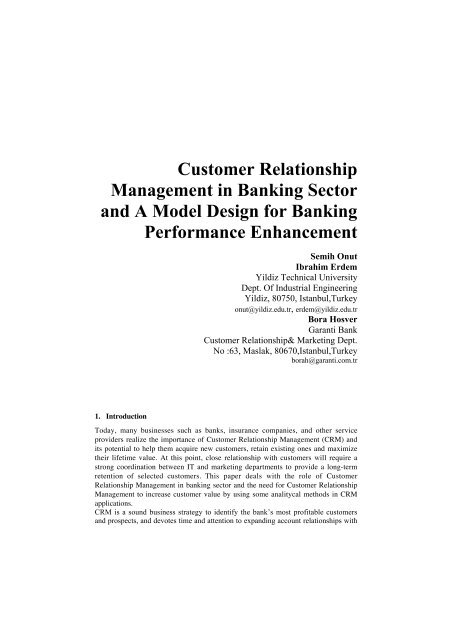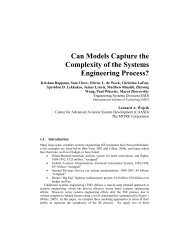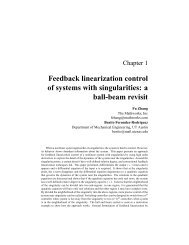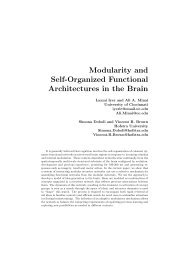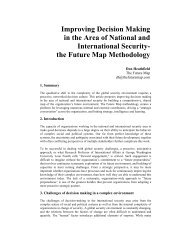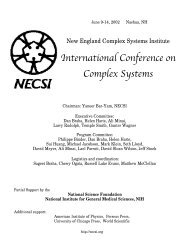Customer Relationship Management in Banking Sector and A Model ...
Customer Relationship Management in Banking Sector and A Model ...
Customer Relationship Management in Banking Sector and A Model ...
Create successful ePaper yourself
Turn your PDF publications into a flip-book with our unique Google optimized e-Paper software.
<strong>Customer</strong> <strong>Relationship</strong><br />
<strong>Management</strong> <strong>in</strong> Bank<strong>in</strong>g <strong>Sector</strong><br />
<strong>and</strong> A <strong>Model</strong> Design for Bank<strong>in</strong>g<br />
Performance Enhancement<br />
Semih Onut<br />
Ibrahim Erdem<br />
Yildiz Technical University<br />
Dept. Of Industrial Eng<strong>in</strong>eer<strong>in</strong>g<br />
Yildiz, 80750, Istanbul,Turkey<br />
onut@yildiz.edu.tr, erdem@yildiz.edu.tr<br />
Bora Hosver<br />
Garanti Bank<br />
<strong>Customer</strong> <strong>Relationship</strong>& Market<strong>in</strong>g Dept.<br />
No :63, Maslak, 80670,Istanbul,Turkey<br />
borah@garanti.com.tr<br />
1. Introduction<br />
Today, many bus<strong>in</strong>esses such as banks, <strong>in</strong>surance companies, <strong>and</strong> other service<br />
providers realize the importance of <strong>Customer</strong> <strong>Relationship</strong> <strong>Management</strong> (CRM) <strong>and</strong><br />
its potential to help them acquire new customers, reta<strong>in</strong> exist<strong>in</strong>g ones <strong>and</strong> maximize<br />
their lifetime value. At this po<strong>in</strong>t, close relationship with customers will require a<br />
strong coord<strong>in</strong>ation between IT <strong>and</strong> market<strong>in</strong>g departments to provide a long-term<br />
retention of selected customers. This paper deals with the role of <strong>Customer</strong><br />
<strong>Relationship</strong> <strong>Management</strong> <strong>in</strong> bank<strong>in</strong>g sector <strong>and</strong> the need for <strong>Customer</strong> <strong>Relationship</strong><br />
<strong>Management</strong> to <strong>in</strong>crease customer value by us<strong>in</strong>g some analitycal methods <strong>in</strong> CRM<br />
applications.<br />
CRM is a sound bus<strong>in</strong>ess strategy to identify the bank’s most profitable customers<br />
<strong>and</strong> prospects, <strong>and</strong> devotes time <strong>and</strong> attention to exp<strong>and</strong><strong>in</strong>g account relationships with
those customers through <strong>in</strong>dividualized market<strong>in</strong>g, repric<strong>in</strong>g, discretionary decision<br />
mak<strong>in</strong>g, <strong>and</strong> customized service-all delivered through the various sales channels that<br />
the bank uses. Under this case study, a campaign management <strong>in</strong> a bank is conducted<br />
us<strong>in</strong>g data m<strong>in</strong><strong>in</strong>g tasks such as dependency analysis, cluster profile analysis, concept<br />
description, deviation detection, <strong>and</strong> data visualization. Crucial bus<strong>in</strong>ess decisions<br />
with this campaign are made by extract<strong>in</strong>g valid, previously unknown <strong>and</strong> ultimately<br />
comprehensible <strong>and</strong> actionable knowledge from large databases. The model<br />
developed here answers what the different customer segments are, who more likely to<br />
respond to a given offer is, which customers are the bank likely to lose, who most<br />
likely to default on credit cards is, what the risk associated with this loan applicant is.<br />
F<strong>in</strong>ally, a cluster profile analysis is used for reveal<strong>in</strong>g the dist<strong>in</strong>ct characteristics of<br />
each cluster, <strong>and</strong> for model<strong>in</strong>g product propensity, which should be implemented <strong>in</strong><br />
order to <strong>in</strong>crease the sales.<br />
2. <strong>Customer</strong> <strong>Relationship</strong> <strong>Management</strong><br />
In literature, many def<strong>in</strong>itions were given to describe CRM. The ma<strong>in</strong> difference<br />
among these def<strong>in</strong>itions is technological <strong>and</strong> relationship aspects of CRM. Some<br />
authors from market<strong>in</strong>g background emphasize technological side of CRM while the<br />
others considers IT perspective of CRM. From market<strong>in</strong>g aspect, CRM is def<strong>in</strong>ed by<br />
[Couldwell 1998] as “.. a comb<strong>in</strong>ation of bus<strong>in</strong>ess process <strong>and</strong> technology that seeks<br />
to underst<strong>and</strong> a company’s customers from the perspective of who they are, what they<br />
do, <strong>and</strong> what they are like”. Technological def<strong>in</strong>ition of CRM was given as “.. the<br />
market place of the future is undergo<strong>in</strong>g a technology-driven metamorphosis”<br />
[Peppers <strong>and</strong> Rogers 1995]. Consequently, IT <strong>and</strong> market<strong>in</strong>g departments must work<br />
closely to implement CRM efficiently. Meanwhile, implementation of CRM <strong>in</strong><br />
bank<strong>in</strong>g sector was considered by [Mihelis et al. 2001]. They focused on the<br />
evaluation of the critical satisfaction dimensions <strong>and</strong> the determ<strong>in</strong>ation of customer<br />
groups with dist<strong>in</strong>ctive preferences <strong>and</strong> expectations <strong>in</strong> the private bank sector. The<br />
methodological approach is based on the pr<strong>in</strong>ciples of multi-criteria model<strong>in</strong>g <strong>and</strong><br />
preference disaggregation model<strong>in</strong>g used for data analysis <strong>and</strong> <strong>in</strong>terpretation. [Yli-<br />
Renko et al. 2001] have focused on the management of the exchange relationships<br />
<strong>and</strong> the implications of such management for the performance <strong>and</strong> development of<br />
technology-based firms <strong>and</strong> their customers. Spesifically the customer relationships of<br />
new technology-based firms has been studied. [Cook <strong>and</strong> Hababou, 2001] was<br />
<strong>in</strong>terested <strong>in</strong> total sales activities, both volume-related <strong>and</strong> non-volume related. They<br />
also developed a modification of the st<strong>and</strong>ard data envelope analysis (DEA) structure<br />
us<strong>in</strong>g goal programm<strong>in</strong>g concepts that yields both a sales <strong>and</strong> service measures.<br />
[Beckett-Camarata et al. 1998] have noted that manag<strong>in</strong>g relationships with their<br />
customers (especially with employees, channel partners <strong>and</strong> strategic alliance<br />
partners) was critical to the firm’s long-term success. It was also emphasized that<br />
customer relationship management based on social exchange <strong>and</strong> equity significantly<br />
assists the firm <strong>in</strong> develop<strong>in</strong>g collaborative, cooperative <strong>and</strong> profitable long-term<br />
relationships. [Yuan <strong>and</strong> Chang 2001] have presented a mixed-<strong>in</strong>itiative synthesized<br />
learn<strong>in</strong>g approach for better underst<strong>and</strong><strong>in</strong>g of customers <strong>and</strong> the provision of clues for<br />
improv<strong>in</strong>g customer relationships based on different sources of web customer data.
They have also hierarchically segmented data sources <strong>in</strong>to clusters, automatically<br />
labeled the features of the clusters, discovered the characteristics of normal, defected<br />
<strong>and</strong> possibly defected clusters of customers, <strong>and</strong> provided clues for ga<strong>in</strong><strong>in</strong>g customer<br />
retention. [Peppers 2000] has also presented a framework, which is based on<br />
<strong>in</strong>corporat<strong>in</strong>g e-bus<strong>in</strong>ess activities, channel management, relationship management<br />
<strong>and</strong> back-office/front-office <strong>in</strong>tegration with<strong>in</strong> a customer centric strategy. He has<br />
developed four concepts, namely Enterprise, Channel management, <strong>Relationship</strong>s <strong>and</strong><br />
<strong>Management</strong> of the total enterprise, <strong>in</strong> the context of a CRM <strong>in</strong>itiative. [Ryals <strong>and</strong><br />
Knox 2001] have identified the three ma<strong>in</strong> issues that can enable the development of<br />
<strong>Customer</strong> <strong>Relationship</strong> <strong>Management</strong> <strong>in</strong> the service sector; the organizational issues of<br />
culture <strong>and</strong> communication, management metrics <strong>and</strong> cross-functional <strong>in</strong>tegrationespecially<br />
between market<strong>in</strong>g <strong>and</strong> <strong>in</strong>formation technology.<br />
3. CRM Objectives <strong>in</strong> Bank<strong>in</strong>g <strong>Sector</strong><br />
The idea of CRM is that it helps bus<strong>in</strong>esses use technology <strong>and</strong> human resources ga<strong>in</strong><br />
<strong>in</strong>sight <strong>in</strong>to the behavior of customers <strong>and</strong> the value of those customers. If it works as<br />
hoped, a bus<strong>in</strong>ess can: provide better customer service, make call centers more<br />
efficient, cross sell products more effectively, help sales staff close deals faster,<br />
simplify market<strong>in</strong>g <strong>and</strong> sales processes, discover new customers, <strong>and</strong> <strong>in</strong>crease<br />
customer revenues.It doesn't happen by simply buy<strong>in</strong>g software <strong>and</strong> <strong>in</strong>stall<strong>in</strong>g it. For<br />
CRM to be truly effective, an organization must first decide what k<strong>in</strong>d of customer<br />
<strong>in</strong>formation it is look<strong>in</strong>g for <strong>and</strong> it must decide what it <strong>in</strong>tends to do with that<br />
<strong>in</strong>formation. For example, many f<strong>in</strong>ancial <strong>in</strong>stitutions keep track of customers' life<br />
stages <strong>in</strong> order to market appropriate bank<strong>in</strong>g products like mortgages or IRAs to<br />
them at the right time to fit their needs. Next, the organization must look <strong>in</strong>to all of<br />
the different ways <strong>in</strong>formation about customers comes <strong>in</strong>to a bus<strong>in</strong>ess, where <strong>and</strong> how<br />
this data is stored <strong>and</strong> how it is currently used. One company, for <strong>in</strong>stance, may<br />
<strong>in</strong>teract with customers <strong>in</strong> a myriad of different ways <strong>in</strong>clud<strong>in</strong>g mail campaigns, Web<br />
sites, brick-<strong>and</strong>-mortar stores, call centers, mobile sales force staff <strong>and</strong> market<strong>in</strong>g <strong>and</strong><br />
advertis<strong>in</strong>g efforts. Solid CRM systems l<strong>in</strong>k up each of these po<strong>in</strong>ts. This collected<br />
data flows between operational systems (like sales <strong>and</strong> <strong>in</strong>ventory systems) <strong>and</strong><br />
analytical systems that can help sort through these records for patterns. Company<br />
analysts can then comb through the data to obta<strong>in</strong> a holistic view of each customer<br />
<strong>and</strong> p<strong>in</strong>po<strong>in</strong>t areas where better services are needed. In CRM projects, follow<strong>in</strong>g data<br />
should be collected to run process eng<strong>in</strong>e: 1) Responses to campaigns, 2) Shipp<strong>in</strong>g<br />
<strong>and</strong> fulfillment dates, 3)Sales <strong>and</strong> purchase data, 4) Account <strong>in</strong>formation, 5) Web<br />
registration data, 6) Service <strong>and</strong> support records, 7) Demographic data, 8) Web sales<br />
data.<br />
4. A <strong>Model</strong> Design for CRM At Garanti Bank<br />
Garanti Bank, one of the lead<strong>in</strong>g banks <strong>in</strong> Turkey were look<strong>in</strong>g at new ways to<br />
enhance its customer potential <strong>and</strong> service quality. Electronic means of bank<strong>in</strong>g have<br />
proved a success <strong>in</strong> acquir<strong>in</strong>g new customer groups until the end of 2001. After then,
a strategic decision was made to re-eng<strong>in</strong>eer their core bus<strong>in</strong>ess process <strong>in</strong> order to<br />
enhance the bank’s performance by develop<strong>in</strong>g strategic l<strong>in</strong>es. Strategic l<strong>in</strong>es were<br />
given <strong>in</strong> order to meet the needs of large Turkish <strong>and</strong> mult<strong>in</strong>ational corporate<br />
customers, to exp<strong>and</strong> commercial bank<strong>in</strong>g bus<strong>in</strong>ess, to focus expansion <strong>in</strong> retail<br />
bank<strong>in</strong>g <strong>and</strong> small bus<strong>in</strong>ess bank<strong>in</strong>g, to use different delivery channels while<br />
grow<strong>in</strong>g, <strong>and</strong> to enhance operat<strong>in</strong>g efficiency though <strong>in</strong>vestments <strong>in</strong> technology <strong>and</strong><br />
human resources<br />
To support this strategy Garanti Bank has implemented a number of projects s<strong>in</strong>ce<br />
1992 regard<strong>in</strong>g branch organization, processes <strong>and</strong> <strong>in</strong>formation systems. The<br />
adm<strong>in</strong>istration burden <strong>in</strong> the branches has been greatly reduced <strong>and</strong> centralized as<br />
much as possible <strong>in</strong> order to leave a larger room to market<strong>in</strong>g <strong>and</strong> sales. The BPR<br />
projects have been followed by rationaliz<strong>in</strong>g <strong>and</strong> moderniz<strong>in</strong>g the operational systems<br />
<strong>and</strong> subsequently by the <strong>in</strong>troduction of <strong>in</strong>novative channels: <strong>in</strong>ternet bank<strong>in</strong>g, call<br />
center <strong>and</strong> self-servic<strong>in</strong>g. In parallel, usage of technology for <strong>in</strong>ternal communication:<br />
<strong>in</strong>tranet, e-mail, workflow <strong>and</strong> management report<strong>in</strong>g have become widespread.<br />
4.1.CRM Development<br />
To be prepared to the chang<strong>in</strong>g economic conditions <strong>and</strong>, <strong>in</strong> particular, to a rapidly<br />
decreas<strong>in</strong>g <strong>in</strong>flation rate scenario Garanti Bank has started timely to focus on<br />
develop<strong>in</strong>g a customer relationship management (CRM) system. The total number of<br />
customers is presently around two millllions, but an <strong>in</strong>crease to roughly three millions<br />
is foreseen as merg<strong>in</strong>gs with Osmanli Bank <strong>and</strong> Koferzbank are achieved <strong>and</strong> the<br />
present growth targets are reached.<br />
The importance for the bank of manag<strong>in</strong>g the relationhips with their customers has<br />
been the drive of the jo<strong>in</strong>t projects that have been developed with IBM <strong>in</strong> the last<br />
three years. Dur<strong>in</strong>g the projects a number of crucial technological <strong>and</strong> architecture<br />
choices have been made to implement the entire process. Realiz<strong>in</strong>g the importance of<br />
customer <strong>in</strong>formation availability the first of these projects has focussed on the<br />
problem of rout<strong>in</strong>ely collect<strong>in</strong>g <strong>and</strong> cleans<strong>in</strong>g data. The project has been undertaken<br />
by the bank with the spirit that has characterized the whole CRM development. The<br />
project has promoted a massive <strong>in</strong>volvment of the branches, namely of the portfolio<br />
managers <strong>and</strong> campaigns have been launched for populariz<strong>in</strong>g among branch staff the<br />
importance of gather<strong>in</strong>g <strong>and</strong> ma<strong>in</strong>ta<strong>in</strong><strong>in</strong>g reliable customer data. Another set of<br />
methods have been tested for customer not <strong>in</strong>cluded <strong>in</strong> portfolios (pool customers),<br />
such as mail<strong>in</strong>g or distribut<strong>in</strong>g questionnaires <strong>in</strong> the branches or us<strong>in</strong>g automatic teller<br />
mach<strong>in</strong>es (ATM) <strong>and</strong> the call center. Methods for data check<strong>in</strong>g <strong>and</strong> test<strong>in</strong>g have been<br />
developed to be rout<strong>in</strong>ely employed by the bank's staff. Results obta<strong>in</strong>ed are very<br />
good: for portfolio customers data available are respectively 98% for the commercial<br />
ones <strong>and</strong> 85% for the retail ones. For pool customers availability goes down to 65%:<br />
this is a well-known phenomenon due to the loose relationship with the latter<br />
customers.
4.2. Data Warehouse <strong>and</strong> Data M<strong>in</strong><strong>in</strong>g<br />
The Data warehouse is the core of any decision suppport system <strong>and</strong> hence of the<br />
CRM. In implement<strong>in</strong>g its Data Warehouse Garanti Bank has selected an <strong>in</strong>cremental<br />
approach, where the development of <strong>in</strong>formation systems is <strong>in</strong>tegrated with the<br />
bus<strong>in</strong>ess strategy. Instead of develop<strong>in</strong>g a complete design of a corporate Data<br />
Warehouse before implement<strong>in</strong>g it, the bank has decided to develop a portion of the<br />
Data Warehouse to be used for customer relationship management <strong>and</strong> for the<br />
production of accurate <strong>and</strong> consistent management reports. Here we are not concerned<br />
with the latter goal, but are concentrat<strong>in</strong>g on the former.<br />
The Data Warehouse has been designed accord<strong>in</strong>g to the IBM BDW (Bank<strong>in</strong>g Data<br />
Warehouse) model, that has been developed as a consequence of the collaboration<br />
between IBM <strong>and</strong> many bank<strong>in</strong>g customers. The model is currently be<strong>in</strong>g used by 400<br />
banks worldwide. The Garanti Bank Data Warehouse is regularly populated both<br />
from operational systems <strong>and</strong> from <strong>in</strong>termediate sources obta<strong>in</strong>ed by partial<br />
preprocess<strong>in</strong>g of the same raw data.<br />
Figure 1. The process of Relational Market<strong>in</strong>g<br />
It <strong>in</strong>cludes customers' demographic data, product ownership data <strong>and</strong> transaction data<br />
or, more generally product usage data as well as risk <strong>and</strong> profitability data. Most data<br />
are monthly averages <strong>and</strong> today's historical depth is 36 months start<strong>in</strong>g from 1/1/1999<br />
to 12/31/2001. As new data are produced they are placed temporarily <strong>in</strong> an<br />
<strong>in</strong>termediate, from which they are preprocessed <strong>and</strong> transferred to the warehouse. The<br />
importance of the Data Warehouse stems from the analysis of Figure 1. As a result of<br />
strategic decisions customer analysis is carried out by us<strong>in</strong>g data cont<strong>in</strong>uously<br />
updated as well the analytical methods <strong>and</strong> tools to be described later on. The CRM<br />
group analyzes results obta<strong>in</strong>ed <strong>and</strong> designs action plans, such as campaigns,<br />
promotions, special market<strong>in</strong>g <strong>in</strong>itiatives, etc. Plans developed are then implemented<br />
by means of the several channels used by the bank to reach cusomers. Evaluation or<br />
results completes the cycle. The results become an <strong>in</strong>tegral part of the description of<br />
the bank-customer relationship <strong>in</strong> the warehouse. The learn<strong>in</strong>g cycle is thus complete<br />
<strong>and</strong> results obta<strong>in</strong>ed can be reused <strong>in</strong> future analyses <strong>and</strong> <strong>in</strong> future market<strong>in</strong>g plans. It
is easy to underst<strong>and</strong> that the Data Warehouse cannot actually be built 'once for all'<br />
but is a k<strong>in</strong>d of liv<strong>in</strong>g structure cont<strong>in</strong>uously enriched <strong>and</strong> updated as the Relational<br />
Market<strong>in</strong>g activity developes. OLAP (On L<strong>in</strong>e Application Programm<strong>in</strong>g) analyses<br />
are developed by means of Bus<strong>in</strong>ess Object <strong>in</strong> its web version. CRM analysts use this<br />
tool to issue complex SQL queries on the Data Warehouse or on the Analytical<br />
Datamart <strong>and</strong> carry out mono <strong>and</strong> bivariate statistics on the whole customers'<br />
population or on selected groups. Figure 2 shows general structure of Relational<br />
Market<strong>in</strong>g Activity.<br />
Figure 2.The Relational Market<strong>in</strong>g process is supported by a comput<strong>in</strong>g <strong>in</strong>frastructure<br />
where many software packages are <strong>in</strong>tegrated with the bank's <strong>in</strong>formation system.<br />
Data M<strong>in</strong><strong>in</strong>g analyses are not carried out directly on the Data Warehouse, but on the<br />
Analytical Datamart by means of the software package IBM Intelligent M<strong>in</strong>er<br />
[Cabena et.al. 1999], us<strong>in</strong>g as a comput<strong>in</strong>g <strong>and</strong> data server the same ma<strong>in</strong>frame where<br />
the Data Warehouse resides. Garanti Bank believes these tools <strong>and</strong> methodologies are<br />
a powerful competitive weapon <strong>and</strong> is <strong>in</strong>vest<strong>in</strong>g heavily <strong>in</strong> the human resources<br />
needed to develop these analyses.<br />
The Analytical Datamart is derived from the Data Warehouse through the follow<strong>in</strong>g<br />
steps: 1)Raw data process<strong>in</strong>g: data selection, data extraction, <strong>and</strong> data verification<br />
<strong>and</strong> rectification 2) Data modell<strong>in</strong>g <strong>and</strong> variable preprocess<strong>in</strong>g: variable selection,<br />
new variable creation, variable statistics, variable discretization. The above<br />
process<strong>in</strong>g, based on traditional data analysis, is strictly dependent on the <strong>in</strong>vestigated<br />
process; new variable creation, for <strong>in</strong>stance, is <strong>in</strong>tended to aggregate <strong>in</strong>formation<br />
conta<strong>in</strong>ed <strong>in</strong> the raw data <strong>in</strong>to more expressive variables. A simple example is the<br />
number of credit transaction on current account, that conta<strong>in</strong>s much of the<br />
<strong>in</strong>formation conta<strong>in</strong>ed <strong>in</strong> the <strong>in</strong>dividual transactions, but is easier to analyze <strong>and</strong><br />
represent. Variable discretization, based on the distribution of the orig<strong>in</strong>al variables, is<br />
<strong>in</strong>tended to generate categorical variables that better express the physical reality of
the problem under <strong>in</strong>vestigation. The Analytical Datamart is customer centric <strong>and</strong><br />
conta<strong>in</strong>s the follow<strong>in</strong>g data:<br />
1. demographic (age, sex, cultural level, marital status, etc.)<br />
2. ownership of bank's product/services<br />
3. product/services usage (balance, transactions, etc.)<br />
4. global variables : profit, cost, risk, assets, liabilities<br />
5. relationship with the bank: segment, portfolio, etc.<br />
Figure 3. The market<strong>in</strong>g campaign process <strong>and</strong> the software support<strong>in</strong>g it.<br />
4.3.Market<strong>in</strong>g Campaigns<br />
After analyz<strong>in</strong>g strategic <strong>and</strong> analytical CRM we concentrate here on the equally<br />
important operational aspects. Market<strong>in</strong>g Campaigns is the first method that Garanti<br />
Bank has used to test the above described analyses <strong>and</strong> techniques. The overall<br />
campaign process is reported <strong>in</strong> Figure 3, that shows that propensity determ<strong>in</strong>ation<br />
<strong>and</strong> target<strong>in</strong>g are the first step of the whole activity.<br />
A number of experimental campaigns have been designed <strong>and</strong> carried out to test the<br />
soundness of the approach before attempt<strong>in</strong>g a large scale roll-out. Experimental<br />
campaigns have addressed about 900 customers selected with<strong>in</strong> six branch offices <strong>in</strong><br />
Instanbul. An education process has been started by meet<strong>in</strong>g sales forces <strong>in</strong> the branch<br />
offices, by distribution of an explanation booklet <strong>and</strong> by publish<strong>in</strong>g on the Intranet a<br />
note expla<strong>in</strong><strong>in</strong>g the whole process.<br />
System <strong>in</strong>terfaces have been modified <strong>in</strong> order to track the customers under<br />
promotion, as well as to enable salespeople <strong>in</strong> the branch office to complete the sales<br />
on promoted customers as well as to record the fact that the sale was a consequence of<br />
the promotion. The bank has so far used for promotion two channels: the salespeople<br />
<strong>in</strong> the branches <strong>and</strong> the call center. Each channel was used <strong>in</strong> four different<br />
campaigns.
Figure 4. Summary table of experimental promotions deployed by Garanti Bank.<br />
The activity of the call center was supported by the Goldm<strong>in</strong>e software package,<br />
while the overall campaign management was achieved through Valex. This product<br />
used customer data stored <strong>in</strong> the Data Warehouse <strong>and</strong> at the same time manages itself<br />
a smaller local database, where campaign data are temporarily stored (list of<br />
customers, date of promotion, responses, etc.). These data must be copied manually<br />
<strong>in</strong>to the Data Warehouse when the campaign has been completed.<br />
Table <strong>in</strong> Figure 4 reports a summary of the campaigns deployed <strong>and</strong> the results<br />
thereof. By consider<strong>in</strong>g that the maximum response rate obta<strong>in</strong>ed by campaigns run<br />
by us<strong>in</strong>g traditional methods is normally around 1-2%, we see that the benefit of<br />
us<strong>in</strong>g targeted campaigns is very remarkable. As precise measurements on results<br />
obta<strong>in</strong>ed by the bank by us<strong>in</strong>g traditional methods are not available, we cannot<br />
accurately quantify the improvement. An <strong>in</strong>direct measurement of this improvement<br />
comes from the observation that <strong>in</strong> the timeframe where <strong>in</strong>vestment funds campaign<br />
were run, the branch offices <strong>in</strong>cluded <strong>in</strong> the promotion record an <strong>in</strong>crease <strong>in</strong> product<br />
purchase of about 214%, aga<strong>in</strong>st an average 6% throughout the Bank.<br />
Table <strong>in</strong> Figure 4 shows also that the results obta<strong>in</strong>ed by us<strong>in</strong>g the call center as a<br />
promotion channel are equally satisfactory, with the s<strong>in</strong>gle exception of a low result<br />
obta<strong>in</strong>ed on the first campaign on <strong>in</strong>vestment funds.<br />
5.Conclusions<br />
Results obta<strong>in</strong>ed by extensive usage of customer data to develop <strong>and</strong> apply Relational<br />
Market<strong>in</strong>g have conv<strong>in</strong>ced the Garanti Bank to proceed along the l<strong>in</strong>e undertaken. As<br />
lists of customers eligible for four very important bank<strong>in</strong>g product/services are<br />
available, as above described, the follow<strong>in</strong>g actions are now be<strong>in</strong>g deployed:
1. extension of promotions to a larger customer population by hav<strong>in</strong>g sales<br />
people <strong>in</strong> the branches contact<strong>in</strong>g progressively 15,000 customers<br />
2. targeted campaigns through Internet <strong>and</strong> the call center for customers<br />
actively us<strong>in</strong>g one or both of these <strong>in</strong>novative channels for their bank<strong>in</strong>g operations.<br />
The same approach is now be<strong>in</strong>g extended to small <strong>and</strong> medium bus<strong>in</strong>esses <strong>and</strong> to<br />
commercial customers. Moreover the analytical <strong>and</strong> strategic CRM cycle is be<strong>in</strong>g<br />
completed by develop<strong>in</strong>g an application analyz<strong>in</strong>g customers' attrition <strong>and</strong> deploy<strong>in</strong>g<br />
strategies to reduce it.<br />
References<br />
Alis, O.F., Karakurt, E., & Melli, P., 2000, Data M<strong>in</strong><strong>in</strong>g for Database Market<strong>in</strong>g at<br />
Garanti Bank, Proceed<strong>in</strong>g of the International Sem<strong>in</strong>ar "Data M<strong>in</strong><strong>in</strong>g 2000", WIT<br />
Publications.<br />
Beckett-Camarata, E.J., Camarata, M.R., Barker, R.T., 1998, Integrat<strong>in</strong>g Internal <strong>and</strong><br />
External <strong>Customer</strong> <strong>Relationship</strong>s Through <strong>Relationship</strong> <strong>Management</strong>: A Strategic<br />
Response to a Chang<strong>in</strong>g Global Environment, Journal of Bus<strong>in</strong>ess Research, 41,<br />
71-81.<br />
Berry, M.J.A. & L<strong>in</strong>off G.S., 2000, Master<strong>in</strong>g Data M<strong>in</strong><strong>in</strong>g: The Art <strong>and</strong> Science of<br />
<strong>Customer</strong> <strong>Relationship</strong> <strong>Management</strong>, John Wiley & Sons, Inc.<br />
Cabena, P., Choi H.H., Kim I.S., Otsuka S., Re<strong>in</strong>schmidt J. & Saarenvirta G., 1999,<br />
Intelligent M<strong>in</strong>er for Data Applications Guide, IBM Redbooks, SG24-5252-00.<br />
Cook, W.D., & Hababou, M., 2001, Sales Performance Measurement <strong>in</strong> Bank<br />
Branches, Omega, 29, 299 –307.<br />
Couldwell, C., 1998, A Data Day Battle, Comput<strong>in</strong>g, 21 May, 64–66.<br />
Hosk<strong>in</strong>g, J.R.M., Pednault, E. P. D. & Sudan, M., 1997, A statistical perspective on<br />
data m<strong>in</strong><strong>in</strong>, Future Generation Computer Systems, 13, 17-134.<br />
Mihelis, G., Grigoroudis, E., Siskos, Y., Politis, Y., & Mal<strong>and</strong>rakis, Y., 2001,<br />
<strong>Customer</strong> Satisfaction Measurement <strong>in</strong> the Private Bank <strong>Sector</strong>, European<br />
Journal of Operational Research, 347-360.<br />
Peppard, J., 2000, <strong>Customer</strong> <strong>Relationship</strong> <strong>Management</strong> (CRM) <strong>in</strong> F<strong>in</strong>ancial Services,<br />
European <strong>Management</strong> Journal, Vol. 18, No. 3, pp. 312–327,<br />
Peppers, D., & Rogers, M., 1995, A New Market<strong>in</strong>g Paradigm, Plann<strong>in</strong>g Review,<br />
23(2), 14–18.<br />
Ryals, L., & Knox, S., 2001, Cross-Functional Issues <strong>in</strong> the Implementation of<br />
<strong>Relationship</strong> Market<strong>in</strong>g Through <strong>Customer</strong> <strong>Relationship</strong> <strong>Management</strong>, European<br />
<strong>Management</strong> Journal, Vol. 19, No. 5, pp. 534–542.<br />
Yli-Renko, H., Sapienza, H.J., Hay, M., 2001, The Role of Contractual Governance<br />
Flexibility <strong>in</strong> Realiz<strong>in</strong>g the Outcomes of Key <strong>Customer</strong> <strong>Relationship</strong>s, Journal of<br />
Bus<strong>in</strong>ess Ventur<strong>in</strong>g, 16, 529–555.<br />
Yuan, S.T., & Chang, W.L., 2001, Mixed-Initiative Synthesized Learn<strong>in</strong>g Approach<br />
For Web-Based CRM, Expert Systems with Applications, 20, 187-200.


